Archive:SDG 1 - No poverty (statistical annex)
<updatedata> Data extracted in August 2018.
Planned article update: September 2019. <updatedata>
Highlights
<articlecontent>
This article provides an overview of statistical data on SDG 1 ‘No poverty’ in the European Union (EU). It is based on the set of EU SDG indicators for monitoring of progress towards the UN Sustainable Development Goals (SDGs) in an EU context.
This article is part of a set of statistical articles, which are based on the Eurostat publication ’Sustainable development in the European Union — Monitoring report - 2018 edition’. This report is the second edition of Eurostat’s future series of monitoring reports on sustainable development, which provide a quantitative assessment of progress of the EU towards the SDGs in an EU context. <articlecontent> <sesection>
People at risk of poverty or social exclusion
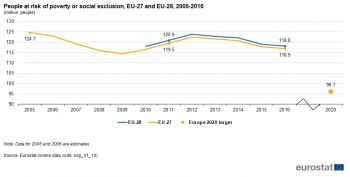
Source: Eurostat (sdg_01_10)
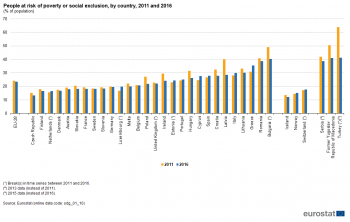
Source: Eurostat (sdg_01_10)
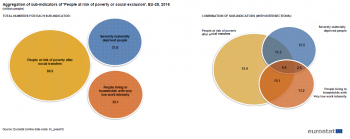
Source: Eurostat (ilc_pees01)
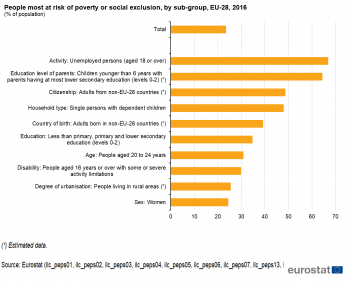
Source: Eurostat : (ilc_pees01), (ilc_peps02), (ilc_peps03), (ilc_peps04), (ilc_peps06), (ilc_peps13), (ilc_peps60) and (hlth_dpe010)
While a household's income is a key determinant of its standard of living, other aspects can prevent people from full participation in society such as an impeded access to labour markets or material deprivation. To reflect these different dimensions of poverty, the broad indicator ‘at risk of poverty or social exclusion’ shows the number of people affected by at least one of the following three forms of poverty: income poverty, severe material deprivation and very low work intensity. Data on the three sub-indicators are derived from the EU Statistics on Income and Living Conditions (EU-SILC).
Figure 1 shows that the number of people at risk of poverty or social exclusion in the EU was lower in 2016 than in 2005. On average, this amount fell by 0.6 % per year in the EU-27 during this period. Slightly less pronounced improvements were achieved in the short term between 2011 and 2016, when this share decreased by an average of 0.4 % per year in the EU-27. Despite the overall improvement in the number of people at risk of poverty or social exclusion over the past decade, the target of lifting at least 20 million people out of the risk of poverty or social exclusion by the year 2020 compared to the year 2008 remains far from being met. To achieve this goal, an average annual decrease of 4.8 % would be required between 2016 and 2020.
People at risk of income poverty after social transfers
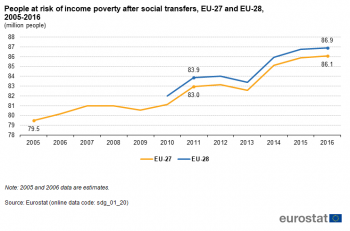
Source: Eurostat (sdg_01_20)

Source: Eurostat (sdg_01_20)
This indicator measures the number of people with an equivalised disposable income below the risk-of-poverty threshold. This is set at 60 % of the national median equivalised [1] disposable income after social transfers. The data stem from the EU Statistics on Income and Living Conditions (EU-SILC).
Figure 5 shows that income poverty has been spreading across the EU over the past decade. Both in the long term (since 2005) and the short term (since 2011) the number of people at risk of income poverty in the EU-27 after social transfers has increased gradually at an average annual rate of 0.7 %.
Severely materially deprived people
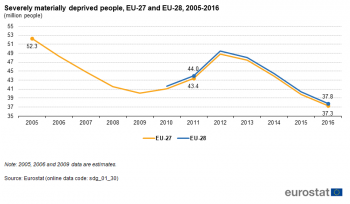
Source: Eurostat (sdg_01_30)

Source: Eurostat (sdg_01_30)
This indicator covers issues relating to economic strain, durables, housing and the environment of dwellings. Severely materially deprived people have living conditions greatly constrained by a lack of resources, which means they cannot afford at least four of the following items: to pay their rent or utility bills, to keep their home warm, to pay unexpected expenses, to eat meat, fish or other protein-rich nutrition every second day, a week holiday away from home, a car, a washing machine, a colour TV or a telephone. Data for this indicator stem from the EU Statistics on Income and Living Conditions (EU-SILC).
Despite a temporarily increase in the number of people living in severe material deprivation between 2009 and 2012, there has been an overall favourable development, as shown in Figure 7. Over both the long and short terms, this number decreased by 3.0 % per year on average in the EU-27.
People living in households with very low work intensity
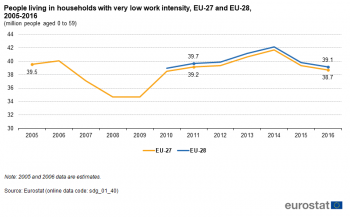
Source: Eurostat (sdg_01_40)
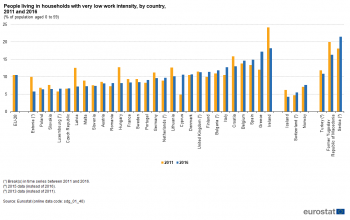
Source: Eurostat (sdg_01_40)
This indicator describes the number of people aged 0 to 59 living in households where the adults worked less than 20 % of their work potential during the past year. The EU Statistics on Income and Living Conditions (EU-SILC) are the data source for this indicator.
In 2016, the number of people living in households with very low work intensity was slightly below the number observed both in 2005 and in 2011. This means there was an average annual fall of 0.2 % in the EU-27 over both the short and long terms. In between, however, this number fluctuated considerably. Primarily, the onset of the economic crisis and the subsequent recovery had an influence on this development.
In work at-risk-of-poverty rate
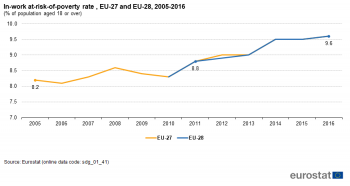
Source: Eurostat (sdg_01_41)
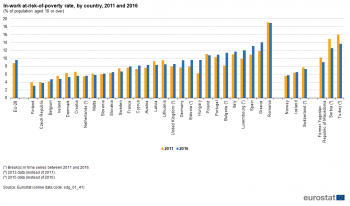
Source: Eurostat (sdg_01_41)
This indicator refers to the share of employed people aged 18 years or over at risk of income poverty. People are considered ‘employed’ if they held a job for more than half of the reference year. Data for this indicator are taken from the EU Statistics on Income and Living Conditions (EU-SILC).
Although there has been a slightly favourable development in the amount of people living in households with very low work intensity (see Figure 9), being in work has become less of an insurance against poverty. Over the past decade, the share of so-called working poor has increased with an average of 1.4 % annually in the EU-27. The development is more dire when only considering the short-term trend since 2011, with an average annual growth rate of 1.8 %.
Population living in a dwelling with a leaking roof, damp walls, floors or foundation or rot in window frames or floor
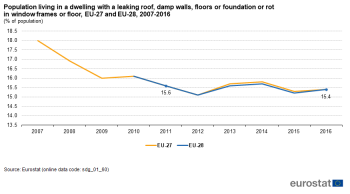
Source: Eurostat (sdg_01_60)

Source: Eurostat (sdg_01_60)
The indicator reflects the share of the population with at least one of the following deficits in their home: a leaking roof, damp walls, floors or foundation, or rot in window frames or floor. This indicator is derived from the EU Statistics on Income and Living Conditions (EU-SILC). Between 2007 and 2016, considerable progress was made in reducing the share of people burdened by inadequate housing. However, most of this progress occurred between 2007 and 2012. Even so, in the short term between 2011 and 2016 the rate still fell by an average of 0.3 % per year in the EU-28.
See also
Further Eurostat information
Database
- Socioeconomic Development
Dedicated section
Methodology
More detailed information on EU SDG indicators for monitoring of progress towards the UN Sustainable Development Goals (SDGs), such as indicator relevance, definitions, methodological notes, background and potential linkages, can be found in the introduction of the publication ’Sustainable development in the European Union — Monitoring report - 2018 edition’.
Notes
- ↑ The equivalised disposable income is the total income of a household, after tax and other deductions, that is available for spending or saving, divided by the number of household members converted into equalised adults; household members are equalised or made equivalent by weighting each according to their age, using the so-called modified OECD equivalence scale.





